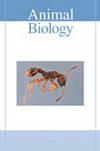我该走还是该留:在印度的农业景观中,罗素毒蛇达伯亚·罗素(Shaw & Nodder, 1797)的逃跑行为
IF 0.9
4区 生物学
Q2 ZOOLOGY
引用次数: 0
摘要
捕食对猎物施加了很强的选择力,因此猎物物种进化出了多种逃避捕食的方法。许多移动物种逃避捕食的一种策略是当捕食者靠近时逃跑。然而,过早逃离可能会造成健康成本。因此,最优逃跑理论表明,猎物的逃跑行为取决于被吃掉的风险和逃跑成本。几项关于哺乳动物、鸟类和蜥蜴的研究支持了这一假设。然而,很少有研究探索蛇的逃跑行为。在这里,我们使用无线电遥测技术在野外追踪蛇,研究罗素毒蛇的逃跑行为,这是一种剧毒而神秘的蛇,是印度被蛇咬伤死亡人数最多的蛇。我们发现,逃跑反应,即留下来或逃跑的决定,受到内在因素的影响,如蛇的行为和体温。我们还表明,飞行起始距离,即蛇逃离的距离,主要取决于栖息地选择,即蛇的能见度和到最近掩体的距离。总的来说,我们表明不同的因素可以决定逃跑的决定和何时逃跑。我们还强调了如何理解这种剧毒,医学上重要但神秘的蛇的逃跑反应可能有助于减少人蛇相遇并减轻蛇咬伤危机。本文章由计算机程序翻译,如有差异,请以英文原文为准。
Should I stay or should I go: escape behaviour of Russell’s vipers, Daboia russelii (Shaw & Nodder, 1797) in India’s agricultural landscapes
Predation exerts a strong selective force on prey, and hence prey species have evolved a multitude of ways to escape predation. One strategy by which many mobile species escape predation is by fleeing when approached by predators. However, fleeing too early can have fitness costs. Thus, optimal escape theory suggests that escape behaviour in prey depends on the risk of being eaten and the fleeing costs. Several studies on mammals, birds and lizards lend support to this hypothesis. However, few studies have explored escape behaviour in snakes. Here, using radio telemetry to track snakes in the field, we study the escape behaviour in Russell’s vipers, a highly venomous and cryptic snake, responsible for the highest number of snakebite deaths in India. We show that escape response, i.e., the decision to stay or flee, was influenced by intrinsic factors such as the snake’s behaviour and body temperature. We also show that the flight initiation distance, the distance at which the snake flees, was mostly determined by habitat selection, i.e., the visibility of the snake and the distance to the nearest cover. Overall, we show that different factors could determine the decision to flee and when to flee. We also highlight how understanding escape response in such highly venomous, medically important yet secretive snakes could potentially help reduce human-snake encounters and mitigate the snakebite crisis.
求助全文
通过发布文献求助,成功后即可免费获取论文全文。
去求助
来源期刊

Animal Biology
生物-动物学
CiteScore
2.10
自引率
0.00%
发文量
34
审稿时长
3 months
期刊介绍:
Animal Biology publishes high quality papers and focuses on integration of the various disciplines within the broad field of zoology. These disciplines include behaviour, developmental biology, ecology, endocrinology, evolutionary biology, genomics, morphology, neurobiology, physiology, systematics and theoretical biology. Purely descriptive papers will not be considered for publication.
Animal Biology is the official journal of the Royal Dutch Zoological Society since its foundation in 1872. The journal was initially called Archives Néerlandaises de Zoologie, which was changed in 1952 to Netherlands Journal of Zoology, the current name was established in 2003.
 求助内容:
求助内容: 应助结果提醒方式:
应助结果提醒方式:


